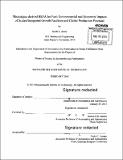Microalgae-derived HEFA jet fuel : environmental and economic impacts of scaled/integrated growth facilities and global production potential
Author(s)
Ames, Jacob L. (Jacob Lee)
DownloadFull printable version (9.532Mb)
Alternative title
Microalgae-derived hydro-processed esters and fatty acids jet fuel
Environmental and economic impacts of scaled/integrated growth facilities and global production potential
Other Contributors
Massachusetts Institute of Technology. Department of Aeronautics and Astronautics.
Advisor
Steven R.H. Barrett.
Terms of use
Metadata
Show full item recordAbstract
Biofuels have the potential to mitigate the environmental impact of aviation and offer increased energy security through the displacement of conventional jet fuel. This study investigates strategies designed to reduce the production cost and lifecycle greenhouse gas (GHG) emissions of microalgae-derived HEFA jet fuel. Additionally, the global production potential of HEFA-J is quantified in order to assess the efficacy of microalgae as an energy crop. Impacts from the integration/scaling of microalgae cultivation were quantified by calculating avoided costs and GHG emissions from inputs displaced as a result of integration/scaling. Avoided costs and emissions associated with each impacted input were calculated in units of $/galHEFA-J and gCO₂e/MJHEFA-J, respectively. Results were summed to produce total impact values and resulting production cost/lifecycle emissions values of HEFA-J for each strategy investigated. Baseline results indicate that integration with wastewater treatment (WWT) facilities may reduce production cost and lifecycle GHG emissions of HEFA-J by 29.2% and >100%, respectively, in open pond systems. Integration with aquaculture processes may reduce production cost by 10.4% in open ponds. Scaling microalgae cultivation from 137 to 2192 barrels per day (BPD) results in a 22.7% reduction in production cost and a 32.0% reduction in lifecycle GHG emissions in open pond systems. Combining scaling and WWT integration methods in open ponds yields a 52.0% reduction in production cost and >100% lifecycle GHG emissions reduction. Global production potential of microalgae-derived HEFA-J is quantified through the summation of annual energy yields of cells at a 5 arc minute resolution. Results are constrained by geographically variable biological growth factors in addition to water/CO₂ transportation constraints, land availability and slope, and industrial CO₂ availability. Maximum jet and maximum distillate product slates were applied to total energy potential results to quantify global production potential of HEFA-J. Baseline results indicate that 27.5 EJHEFA-J/yr may be produced, or approximately 3 times the annual global aviation energy demand.
Description
Thesis: S.M., Massachusetts Institute of Technology, Department of Aeronautics and Astronautics, February 2015. Cataloged from PDF version of thesis. "February 2015." Includes bibliographical references (pages 71-74).
Date issued
2015Department
Massachusetts Institute of Technology. Department of Aeronautics and AstronauticsPublisher
Massachusetts Institute of Technology
Keywords
Aeronautics and Astronautics.